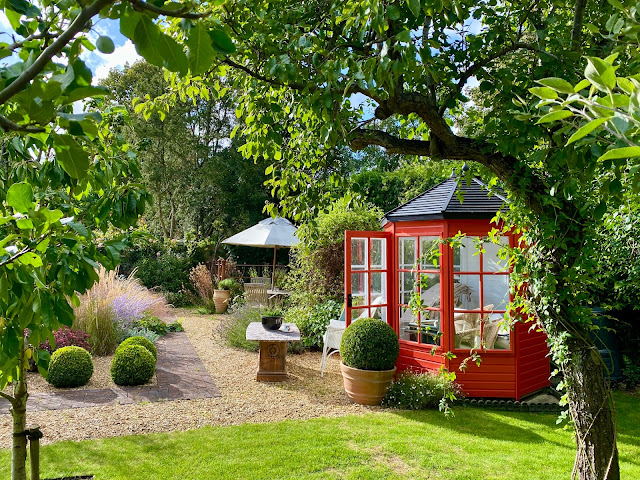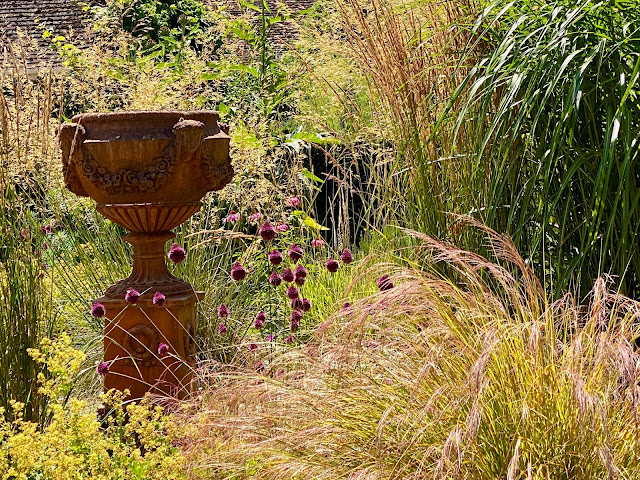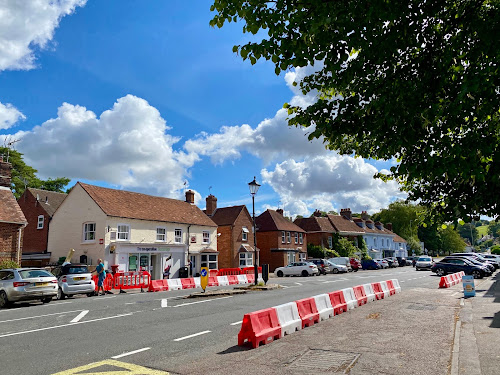The summerhouse is the focal point of the garden and at the same time provides one of the best viewpoints. It is also the main spot for tea or an early drink. It took some time to acquire its present colour. For some years it was painted the usual blue/grey, but I grew tired of that 'safe' shade and taking my inspiration from a friend's garden in which he had installed
a Chinese bridge, I decided to follow the ancient rule that a garden should always contain a building in red. Getting the right colour was tricky as I wanted the shade used in Japanese temples such as
Fushimi Inari, and of course, I wasn't able to find it as it's a closely held secret, but this was the closest I could have mixed. This winter I will have it varnished in marine varnish, both to preserve it - as the colour is now 'settled' - and to bring out a richer and a slightly more orange hue closer the Inari temple red.

The main lawn has come back well after all the rain, and everything's looking lush. The vine has arched over the path to envelop the quince. The Raphael seat though has stubbornly resisted all attempts to get it to age quickly, despite being covered at various times with seaweed manure, pond silt and yoghurt. I'll just have to wait for nature to take its course!
This bed - the lower drive border - suffered worst during the exceedingly wet winter and took a long time to recover. I had dug out the old euphorbia wulfenii in the autumn and replanted some new ones but they were still small and I had hoped to rely on large plants like the
archangelica to provide interest - but it was killed off and its replacement got caught up in the chaos of the closure of the garden centres and the scramble in the nurseries to catch up when they reopened. So the new plant didn't arrive until June and is even now only about the height of the rest when it should be towering above. Fortunately, though, the trusty nepetas and alchemillas, along with, sedum, stachys, rosemary and some euphorbia martini, saved the day. And Penny Burnfield has just given me a lovely plant - Succisella inflexa 'Frosted Pearls' that complements the verbena and the self-seeded dill.

The box walk after rain - with the armillary sphere presiding. Hydrangea seemanii is doing well on the wall in the corner and the newly planted erigeron is doing predictably well.
The two sedums in the grass garden are both strong reds and stand out against the pale gravel. Plants that are absolutely no trouble and always look good are a joy!
Another view of the lower drive border showing the mass of verbena (though I would love more) against the rosemary with stachys and sedum at its base
Hydrangea 'Annabelle' has been grown in a pot for several years because it hides and old tree-stump at the back of the wild-flower garden. It's the only version in this garden, though it provides many gardens with a huge display.
Perfectly trimmed box (by the sainted Bruce Williams) in the grass garden backed by one of the dark red sedums, calamagrostis 'Karl Forester' and perovskia 'Blue Spire'
Allium spherocephalum seedheads in the grass garden
A moody sky frames my neighbours' catalpa and the magnificent Scots pine. Invisible in the darkness is the spire of St Peter's.
The first flush of hazelnuts brings out the squirrels who bury those they don't immediately eat and in the lawn
My early morning view down the garden with a cup of coffee from the window in the scullery while checking what's changed in the night.
Another view of the box, sedum and perovskia, overseen by 'Karl Forester' but also showing the relationship with the rose-covered west wall.
'Annabelle' gets another look in in this photo of the wildflower garden, with the base of rose 'Wedding Day' (which already reaches the top of my neighbours' yew tree) and a newly planted euphorbia stygiana that will one day dominate. The whole area (except of course the euphorbia and the begonia) will be cleared in September, and partially regrow, before dying down in the winter.
One of my favourite views taken from the summerhouse at tea-time, though the lavender to the alchemilla, the pheasant grass and the mass of eryngiums and echinops below rose 'Compassion' on the West wall
One of the box balls leads the eye through the brick piers towards the deckchairs where tea is taken on hot days, as the hazel casts a lovely cool shade. The pelargonium is 'Pink Capricorn' originally introduced by Gillian Pugh
The box from another angle, with the pheasant grass (anemanthele lessonia)
and a potted euphorbia 'Arctic Blue'.
The is what the garden is all about. Places to sit and eat, or drink, or just read a book while cocooned by tall hedges to keep out the wind, and given a panorama of plants to look at. Here the table is backed by perovskia and miscanthus 'Prof Richard Hansen', the tallest of he grasses.
The view from the Lutyens bench on 'Venky's Terrace', though the orchard towards the summerhouse and the grass garden. The closest tree is an apple - 'James Grieve' - that has a trachelospermum jasmine trained up it. The plum tree on the right has rose 'Felicite et Perpetue' trained onto it.
I have a love/hate relationship with this echinops, here at its best showing its gorgeous mauve/purple globes, but otherwise too much of a 'thug', pushing everything else out of the lower wall border.
Earlier in August the allium spherocephalum was still at its dark red best against the grasses, delicate beside the powerful urnin pressed brick.
Another favourite view - looking towards the wildflower garden with the lower wall border flanking the path with teucrium and echinops competing with the eryngiums. Teazle and wild carrot stand guard at the gate into the wildflowers.In the grass garden, perovskia hasn't yet achieved full wattage and the alchemlla is still fresh.
There are now mnay shades of echinacea - and I have forgotten which this one is....
The black bamboo is doing well against the west wall, and has a tower of reclaimed bricks for company.

\
The 'other' red sedum in the grass garden, not as vibrant as the other but softer against the perovskia 'Lacy Blue'
There are teo kinds of perovskia in the grass garden and this one, 'Blue Spire' is perhaps oo big (and has been somewhat flattened by heavy rain). But it makes up for its size by its incredibly strong colour.
Another classic view - this one from my 'reading chair' in the shade of the orchard. The grass garden pays homage to the great Scots pine in the background.
This is not a fake! The perovskias really are as bright as this, and now compete with the helenium 'Moreheim Beauty' and the echinacea
A complete contrast with all the colour at the other end of the garden; a calm green oasis of lawn and clipped box.
Verbena, angelica, dill and stachys backed by rosemary in the lower wall border
The view under the hazel through the brick piers towards the house. The Portuguese laurel looks like a huge variegated box ball
Another view of the grass garden looking west to the Scots pine.
Euphorbia 'Arctic Blue' in an urn in the grass garden
The teazel and wild carrot self-seeded and making sure no one gets in our out of the wildflower garden.
The wild carrot ages beautifully
The orchard now has some decent specimens. Greengage in the foreground and Mirabelle on the left.
The wildflower garden is fenced with out-of-scale estate fencing that is rusting beautifully. The urn contains sage.
This wide-angle view is dominated by the self-seeded wild carrot and the somewhat wild sky.
A favourite view enhanced enormously by the 'borrowed landscape'.





















































